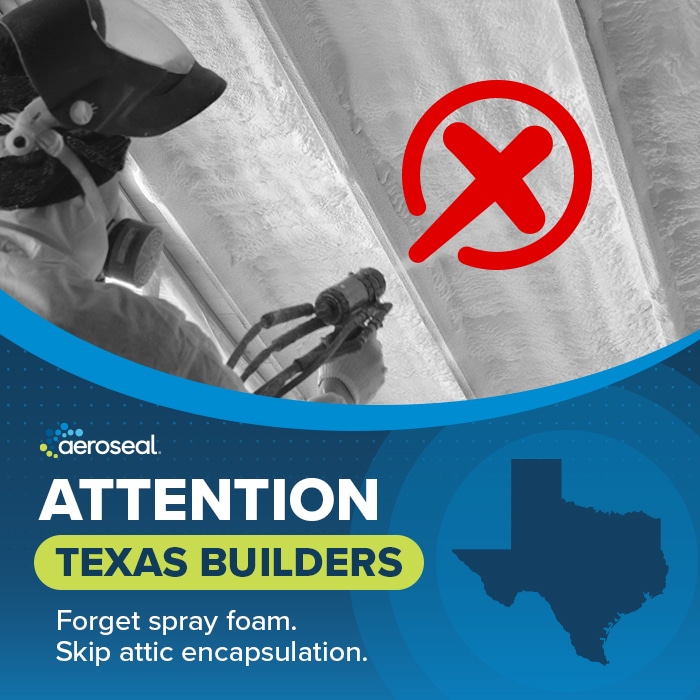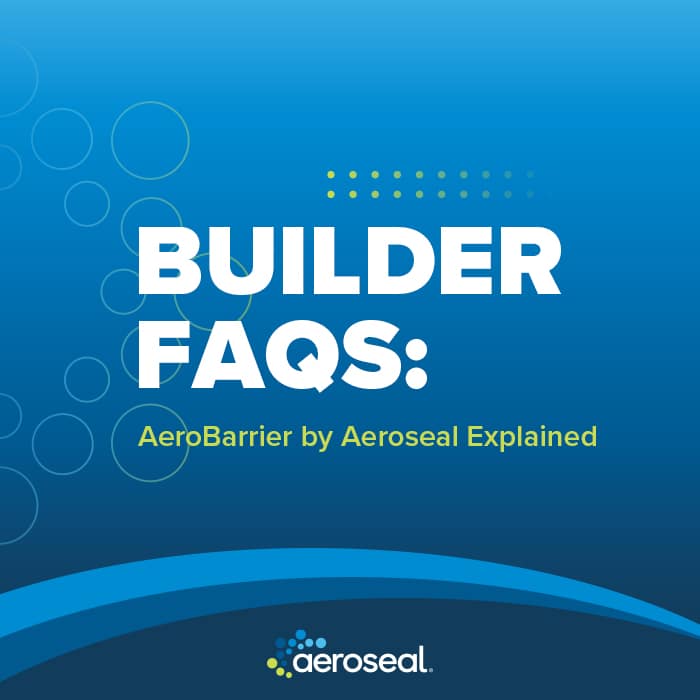Blower Door Test: How Aeroseal’s AeroBarrier™ Helps Builders Pass with Ease

For new construction builders, passing a blower door test is a critical step in meeting energy codes and ensuring that buildings are energy-efficient, comfortable, healthy, and durable. A blower door test measures the air leakage of a building’s envelope, identifying air leaks that can lead to energy waste, higher operating costs, reduced indoor comfort, less indoor air quality, and moisture in the exterior wall.
However, passing this test can be challenging, especially when air leaks are hard to find or seal. That's where AeroBarrier™, an advanced building envelope sealing solution from Aeroseal, comes into play.
By effectively sealing leaks and immediately verifying that the air tightness requirement has been met, AeroBarrier helps builders not only pass blower door tests but also exceed energy efficiency standards and improve indoor air quality, making projects more appealing to environmentally conscious clients
What Is a Blower Door Test?
A blower door test is used to assess how airtight a building is by measuring the amount of air that escapes through cracks, gaps, and holes in the building envelope. Performing the test involves placing a specialized fan set in fabric and a frame in an exterior door to depressurize the building, and then measuring the pressure loss inside the building as air leaks outside through the cracks, gaps, and holes in the envelope. This test determines the amount of air leakage present in the building envelope.
How Blower Door Test Results are Measured
Blower door test results showing air tightness are typically expressed in cubic feet per minute at 50 Pascals of pressure (CFM50) or air changes per hour at 50 Pascals of pressure (ACH50).
CFM50 measures the amount of air in cubic feet per minute needed to create a 50 pascal change in building pressure, while ACH50 reports the number of times per hour that the entire volume of air in the building is replaced through leakage. For example, an air leakage rate of 3 ACH50 means that for each hour, all of the air inside the building is leaking outside 3 times. You can calculate ACH by multiplying the CFM50 from the blower door test by 60 to get air flow per hour, then dividing that number by the volume of the interior of the house in cubic feet.
The lower the ACH50 score the better, indicating that the building has less air leakage through the building envelope and is more airtight.
For builders, achieving a low ACH score is critical in demonstrating that the building meets energy efficiency and green building standards.
Why Passing the Blower Door Test Matters for Builders
Blower door tests are required by many building codes and energy certification programs, such as the International Energy Conservation Code (IECC), ENERGY STAR, Zero Energy Ready Home (ZERH), and LEED. Failing the test can mean costly delays, additional labor, and the need for difficult rework.
Home builders who fail to meet airtightness requirements aren’t able to sell or lease those properties until the air leakage is corrected, delaying their sales revenue.
In new construction, especially energy-efficient homes and commercial properties, achieving the airtightness required by the test is a sign of high-quality construction. It assures clients that their building will have lower energy costs, a comfortable and healthier indoor environment, and a more durable exterior envelope.
How AeroBarrier Makes Passing the Blower Door Test Easier
AeroBarrier provides builders with a proven solution to tackle the challenge of air leaks in the building envelope. Here’s how our technology helps you pass blower door tests with ease.
The automated system seals the building envelope from inside the building. AeroBarrier’s air sealing system pressurizes a space using a blower door and fan, then sprays an atomized, nontoxic sealant mist into that space, causing the sealant to follow the higher pressure inside air escaping through leaks in the building envelope to the outside and sealing those leaks as it passes through them. Leaks as small as a human hair and up to ½ inch in size are easily and accurately sealed. A continuous blower door test is run while the seal is taking place, providing air tightness results every 60 seconds. Once the desired air tightness level is achieved, the system is shut off and an Envelope Sealing Report is provided that verifies the air tightness is achieved before our installer leaves the construction site.
- Guaranteed: AeroBarrier ensures that you will meet your air tightness requirement.
- Verified immediately: we run a continuous blower door test that reports air tightness results every seconds, letting you know you’ve met your air tightness requirement before our installer leaves your job site.
- Meets and Exceeds Codes: Builders can confidently meet or exceed energy codes and certification requirements with a sealed building envelope.
- Saves Time and Labor: AeroBarrier is applied quickly and efficiently, reducing the need for manual labor and follow-up repairs.
Pass Your Blower Door Test with Confidence
Passing a blower door test is essential for meeting building code and energy efficiency standards, while ensuring that your building delivers on comfort and cost savings.
AeroBarrier’s envelope sealing solution makes the process guaranteed, simpler and more reliable, allowing builders to pass the test and move forward with their projects.
Whether you’re building energy-efficient homes or large commercial spaces, AeroBarrier can help you achieve airtight construction, reduce air leaks, and improve overall building performance.







